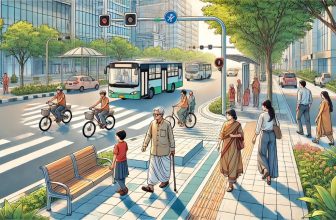Not every crisis is loud. Some unfold slowly, affecting lives across the country without triggering media debates or public outrage. These are the quiet struggles—overlooked, normalized, or buried under more visible narratives. In India, several serious social issues are hiding in plain sight. They don’t trend on social media, but they shape futures, limit opportunities, and deepen inequality.
This list brings to light 12 such silent social crises—urgent, real, and long overdue for national attention.
1. Neglect of the Elderly in Urban Homes
With rising urban migration and shrinking joint families, many senior citizens in Indian cities live in quiet isolation. Without emotional support, digital literacy, or affordable care services, they face loneliness, mental health issues, and neglect. Despite an ageing population, elderly welfare is rarely part of everyday conversations.
2. Girls Dropping Out of School—Especially Post-Pandemic
In rural and low-income urban areas, many girls have not returned to school after COVID-19 closures. Reasons include household responsibilities, early marriage, and lack of access to digital learning. This setback threatens to undo years of progress in girls’ education—quietly, without headlines.
3. Rising Mental Health Struggles Among Youth
From exam anxiety to social media pressure, Indian teens and college students are facing rising levels of stress, depression, and isolation. Yet mental health is still stigmatized in schools and homes. There’s a shortage of school counsellors and accessible mental health support, especially in non-metro areas.
4. Unpaid and Invisible Care Work by Women
Indian women continue to bear the burden of cooking, cleaning, caregiving, and managing households—often without recognition or compensation. This unpaid work limits their ability to pursue careers, education, or rest. It’s one of the biggest gender gaps in Indian society, but rarely addressed in policy or popular culture.
5. Digital Fatigue and Overexposure in Children
Increased screen time due to online classes and mobile use has led to sleep issues, reduced physical activity, and emotional imbalance in children. Many parents see digital access as a convenience or necessity, but the long-term effects on health and development are quietly building up.
6. Manual Scavenging Still Exists Despite the Ban
Though banned by law, manual scavenging continues in parts of India, mostly by people from Dalit communities. Lack of mechanization, poor enforcement, and social stigma keep this inhumane practice alive. These workers face health hazards, social exclusion, and little opportunity for change.
7. Chronic Malnutrition Among Tribal Children
Tribal communities in states like Odisha, Chhattisgarh, Jharkhand, and Madhya Pradesh report high rates of undernutrition and stunting. Limited access to healthcare, education, and food security means children grow up with disadvantages that begin before birth—but the crisis remains underreported.
8. Lack of Disability-Friendly Infrastructure
Public spaces, schools, transport, and even government offices in India often remain inaccessible to people with disabilities. Despite the Rights of Persons with Disabilities Act, inclusive design is still not a priority in most infrastructure development. As a result, millions remain excluded from daily participation in public life.
9. Post-Pandemic Learning Loss in Government Schools
While private school students had access to online learning, many students in government schools lost two years of education due to poor digital infrastructure. This learning gap is deep and long-term, but it’s unfolding quietly without urgent public attention or large-scale recovery plans.
10. Water Scarcity in Small Towns and Semi-Urban Areas
Beyond drought-prone villages, smaller towns across India are facing water shortages and irregular supply. Rising population, over-extraction, and poor infrastructure have led to silent water stress—especially in places without political or media focus.
11. Menstrual Hygiene and Period Poverty
Many girls and women in India still lack access to safe, affordable menstrual products. Social stigma, misinformation, and inadequate sanitation make the issue worse. Period poverty leads to health risks and school absenteeism, yet remains a taboo topic in much of the country.
12. Disappearing Local Languages and Cultural Knowledge
India’s linguistic diversity is under threat. As English and dominant state languages take over schools, administration, and media, smaller languages and oral traditions are fading. This quiet loss impacts identity, access to learning, and cultural heritage—especially in tribal and remote regions.
Summary: What India Needs to Start Talking About
| Crisis | Why It Matters |
|---|---|
| 1. Elderly Left Behind | Loneliness and neglect are rising among seniors in cities. |
| 2. Girls Missing from Classrooms | Many girls haven’t returned to school post-pandemic. |
| 3. Youth Mental Health | Stress and anxiety among students is growing quietly. |
| 4. Invisible Women’s Labor | Household work by women remains unpaid and unacknowledged. |
| 5. Kids and Screens | Digital overuse is harming children’s growth and balance. |
| 6. Manual Scavenging Persists | Banned in law, still practiced in silence. |
| 7. Tribal Malnutrition | Undernourished children in tribal regions face lifelong setbacks. |
| 8. Disabled Access Gaps | Public spaces still ignore basic accessibility needs. |
| 9. Learning Loss in Government Schools | Two years of education lost with little recovery effort. |
| 10. Small Town Water Scarcity | Irregular water supply is becoming normal in tier-2 India. |
| 11. Period Poverty | Girls and women lack safe, affordable menstrual products. |
| 12. Language and Culture Loss | India’s smaller languages and local traditions are fading fast. |
Not all crises are visible. These 12 issues may not grab headlines or fuel debates, but they shape the everyday reality of millions. Ignoring them won’t make them disappear. By acknowledging these challenges, sharing them, and pushing for conversation and change, we begin to shift the silence. Because some of the most urgent problems are the ones no one is talking about.





